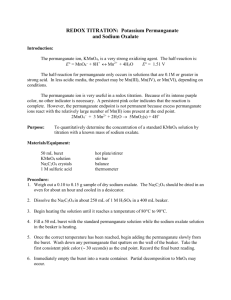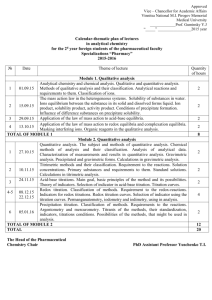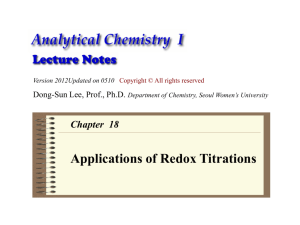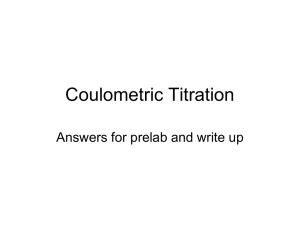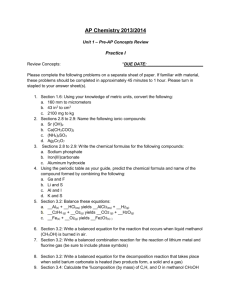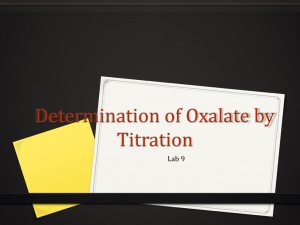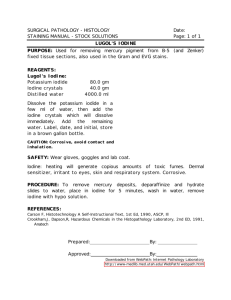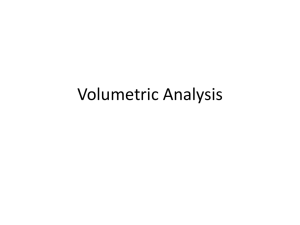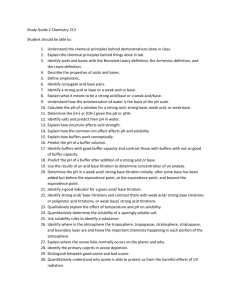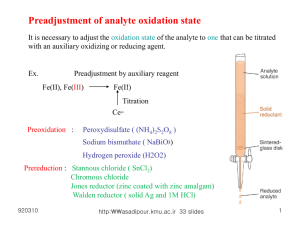Document
advertisement
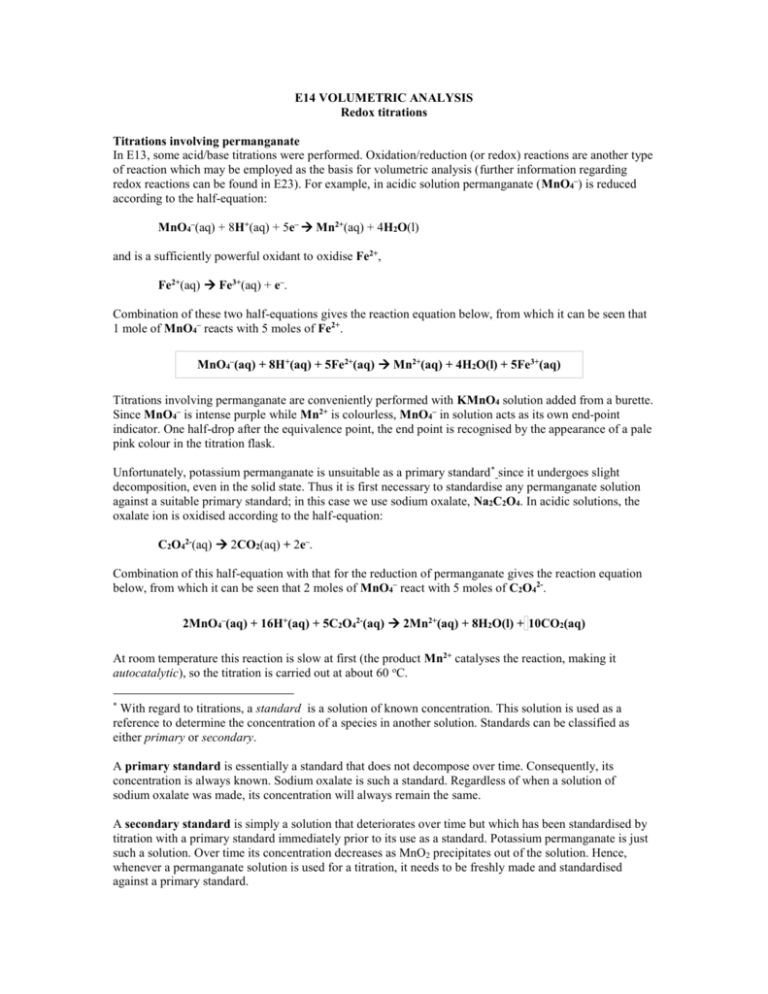
E14 VOLUMETRIC ANALYSIS Redox titrations Titrations involving permanganate In E13, some acid/base titrations were performed. Oxidation/reduction (or redox) reactions are another type of reaction which may be employed as the basis for volumetric analysis (further information regarding redox reactions can be found in E23). For example, in acidic solution permanganate (MnO4–) is reduced according to the half-equation: MnO4–(aq) + 8H+(aq) + 5e– Mn2+(aq) + 4H2O(l) and is a sufficiently powerful oxidant to oxidise Fe2+, Fe2+(aq) Fe3+(aq) + e–. Combination of these two half-equations gives the reaction equation below, from which it can be seen that 1 mole of MnO4– reacts with 5 moles of Fe2+. MnO4–(aq) + 8H+(aq) + 5Fe2+(aq) Mn2+(aq) + 4H2O(l) + 5Fe3+(aq) Titrations involving permanganate are conveniently performed with KMnO4 solution added from a burette. Since MnO4– is intense purple while Mn2+ is colourless, MnO4– in solution acts as its own end-point indicator. One half-drop after the equivalence point, the end point is recognised by the appearance of a pale pink colour in the titration flask. Unfortunately, potassium permanganate is unsuitable as a primary standard * since it undergoes slight decomposition, even in the solid state. Thus it is first necessary to standardise any permanganate solution against a suitable primary standard; in this case we use sodium oxalate, Na2C2O4. In acidic solutions, the oxalate ion is oxidised according to the half-equation: C2O42-(aq) 2CO2(aq) + 2e–. Combination of this half-equation with that for the reduction of permanganate gives the reaction equation below, from which it can be seen that 2 moles of MnO4– react with 5 moles of C2O42-. 2MnO4–(aq) + 16H+(aq) + 5C2O42-(aq) 2Mn2+(aq) + 8H2O(l) + 10CO2(aq) At room temperature this reaction is slow at first (the product Mn2+ catalyses the reaction, making it autocatalytic), so the titration is carried out at about 60 oC. * With regard to titrations, a standard is a solution of known concentration. This solution is used as a reference to determine the concentration of a species in another solution. Standards can be classified as either primary or secondary. A primary standard is essentially a standard that does not decompose over time. Consequently, its concentration is always known. Sodium oxalate is such a standard. Regardless of when a solution of sodium oxalate was made, its concentration will always remain the same. A secondary standard is simply a solution that deteriorates over time but which has been standardised by titration with a primary standard immediately prior to its use as a standard. Potassium permanganate is just such a solution. Over time its concentration decreases as MnO2 precipitates out of the solution. Hence, whenever a permanganate solution is used for a titration, it needs to be freshly made and standardised against a primary standard. The first two experiments of this practical exercise, involve the two processes outlined above: standardisation of a permanganate solution with oxalate, then the use of this newly standardised permanganate solution to determine the purity of a solid specimen of FeSO4.7H2O via a redox titration. This iron compound is usually impure owing to oxidation by air, and so contains less than the expected amount of Fe2+ in a known mass of the solid. Iodometric titrations Iodine and the iodide ion are important reagents in many redox titrations. The half-equation for the oxidation of I– is: 2I–(aq) I2(aq) + 2e– and for the reduction of iodine is: I2(aq) + 2e– 2I–(aq). When iodide is used to reduce another species, the iodide itself is oxidised to iodine. The amount of iodine produced can be determined by reducing it back to iodide using the primary standard thiosulfate, S2O32-. This process is known as an iodometric titration. Thiosulfate is oxidised according to the half-equation: 2S2O32-(aq) S4O62-(aq) + 2e– and combination of this with the reduction half-equation of iodine gives the reaction equation below. From this equation it can be seen that 2 moles of S2O32- react with 1 mole of I2. 2S2O32-(aq) + I2(aq) S4O62-(aq) + 2I–(aq) In the final experiment of this practical exercise, the proportion of hypochlorite ion, ClO–, in samples of different commercial bleach solutions is determined iodometrically. The reaction between ClO– and HCl produces chlorine according to the equation: ClO–(aq) + 2H+(aq) + Cl–(aq) Cl2(aq) + H2O(l) Iodide ion previously added to the solution reacts with the chlorine to form iodine, as shown: Cl2(aq) + 2I– (aq) 2Cl–(aq) + I2(aq) The iodine is then titrated with thiosulfate, as described above. From these equations, then, it can be seen that 1 mole of ClO– produces 1 mole of Cl2 which reacts with excess iodide to produce 1 mole of I2. Since 1 mole of iodine reacts with 2 moles of thiosulfate, we can say that 1 mole of ClO– is equivalent to 2 moles of S2O32-. In other words, if x moles of thiosulfate are used in the titration there would have been x/2 moles of hypochlorite in the sample being titrated. The end point in the titration of iodine with thiosulfate can be determined by the disappearance of the the brown iodine from the solution. In some instances, titrations involving iodine use starch as an indicator as it forms an intense blue complex with iodine. However, in this practical exercise the use of starch is unnecessary. Appendix 5 of the Laboratory Manual details the techniques used in titrations and should be read before the practical session.
